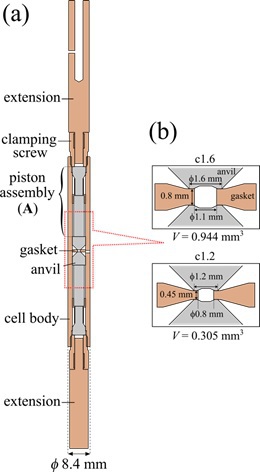Will Magnetic Properties near Pressure Induced Quantum Critical Phenomena Be Elucidated?
The Institute for Solid State Physics, The University of Tokyo
© The Physical Society of Japan
This article is on
Design of Opposed-Anvil-Type High-Pressure Cell for Precision Magnetometry and Its Application to Quantum Magnetism
(JPSJ Editors' Choice)
J. Phys. Soc. Jpn. 90, 074001 (2021).
This article is on
Will Magnetic Properties near Pressure Induced Quantum Critical Phenomena be Elucidated? (JPSJ News and Comments)
JPSJ News Comments 18, 09 (2021).
Hiraoka et al. developed an opposed anvil-type pressure cell for magnetization measurements which combines a large sample space and is capable of generating higher pressures up to 6.3 GPa.
Pressure has proven to be a valuable clean parameter for tuning the physical properties of materials, including the discovery of novel emerging electronic states arising from the interplay of lattice, charge, spin, and orbital degrees of freedom.
At atmospheric pressure, the magnetic properties can be easily measured using commercial instruments such as the magnetic property measurement system (MPMS®) from Quantum Design (USA). To measure the magnetization under a high-pressure custom-designed pressure cell, a clear fitting to the available sample space of an MPMS is required. The typical available sample space in an MPMS has a small diameter of approximately 9.0 mm.
Currently, most high-pressure cells are self-clamp-type piston cylinder apparatus with a relatively large sample space with a maximum pressure range of approximately 3.0 GPa. Furthermore, for magnetization measurements over 3.0 GPa, a ceramic anvil-type pressure cell is used [1]. However, the available sample space that can be used in these opposed-anvil-type devices is severely reduced. Therefore, the measurable materials were only ferromagnets and superconductors, showing a large magnetization signal.
To overcome these bottlenecks, Hiraoka et al. newly developed an opposed-anvil-type pressure cell that combines a large sample volume and is capable of generating higher pressures up to 6.3 GPa. Figure 1 demonstrates a conceptual schematic of a high-pressure cell with a clamp cell body. In addition, using this pressure cell, they successfully demonstrated the detection of weak volume susceptibilities of approximately 10-4, which is sufficient to resolve the magnetism of a paramagnet. Measurements of such high-quality magnetic signals were possible using a technique called truncated singular value decomposition linear algebra.

Fig. 1: Schematic of a high-pressure cell that can be used in a commercial SQUID magnetometer (MPMS, Quantum Design). (a) Cross-section of the cell assembly. Gray and brown indicate the two species of materials, WC (binder less) alloy and Cu–Be alloy, respectively. Zoomed in view of the cupped WC (binder less) anvils (two culet sizes: Φ1.6 mm and Φ1.2 mm) and conical shaped Cu–Be alloy gasket.
Successful implementation of this new technique, with measurements of paramagnetic susceptibilities under pressure revealed a drastic improvement in the magnetic signal. With the advent of such high-precision magnetization measurements under high pressure, it is expected to clarify several unsolved problems, such as magnetic quantum critical phenomena.
Reference
[1] N. Tateiwa, Y. Haga, T. D. Matsuda, Z. Fisk, S. Ikeda, and H. Kobayashi, Rev. Sci. Instrum. 84, 046105 (2013).
Design of Opposed-Anvil-Type High-Pressure Cell for Precision Magnetometry and Its Application to Quantum Magnetism
(JPSJ Editors' Choice)
J. Phys. Soc. Jpn. 90, 074001 (2021).
Will Magnetic Properties near Pressure Induced Quantum Critical Phenomena be Elucidated? (JPSJ News and Comments)
JPSJ News Comments 18, 09 (2021).
